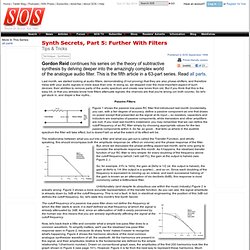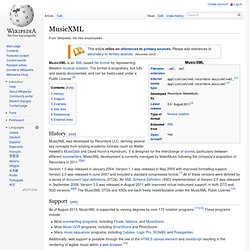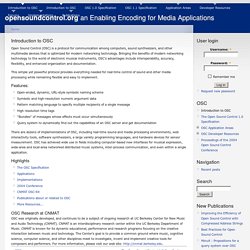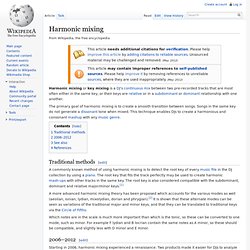

EchoThief. Synth Secrets: Links to All Parts. The OpenSound Control Kit. Welcome to the home page for the OpenSound Control Kit.

Downloads The current version of the OSC Kit is 1.0 (For Mac) Stuffit Archive (For Unix) Compressed tar file Papers Wright, "Implementation and Performance Issues with OpenSound Control", ICMC 1998. Freed and Wright, "Open SoundControl: A New Protocol for Communicating with Sound Synthesizers", ICMC 1997. Presentations HTML version of slides that Matt Wright used when he presented the OSC Kit at ICMC98. Tools for Writing OSC Clients If all your program does is generate OSC messages to send to another program, you're writing an OSC client, which is a lot easier than writing an OSC server.
OSC-client.h - All the documentation for this very simple API exists as comments in this .h file. OSC-client.c - Code that implements the creation of OSC messages. OSC-timetag.h - Header file defining operations on 64-bit OSC time tag values. Tuts+ Free Music & Audio Tutorials. Audio Signal Processing for Music Applications. Synth Secrets, Part 5: Further With Filters. Gordon Reid continues his series on the theory of subtractive synthesis by delving deeper into the amazingly complex world of the analogue audio filter.

This is the fifth article in a 63-part series. Read all parts. Last month, we started looking at audio filters, demonstrating (if not proving) that they are also phase-shifters, and therefore mess with your audio signals in more ways than one. In doing so, we skipped over the most important aspect of such devices: their abilities to remove parts of the audio spectrum and create new tones from old.
But if you think that this is the easy bit, or that you already know how filters attenuate signals, the chances are that you're wrong (on both counts). Passive Filters The relationship between what you put into a filter and what you get out is called the Transfer Function, and strictly speaking, this should encompass both the amplitude response (ie. effect on volume) and the phase response of the filter.
MusicXML. MusicXML is an XML-based file format for representing Western musical notation.

The format is proprietary, but fully and openly documented, and can be freely used under a Public License.[4] History[edit] MusicXML was developed by Recordare LLC, deriving several key concepts from existing academic formats (such as Walter Hewlett's MuseData and David Huron's Humdrum). It is designed for the interchange of scores, particularly between different scorewriters. MusicXML development is currently managed by MakeMusic following the company's acquisition of Recordare in 2011.[5][6] Support[edit] As of August 2013, MusicXML is supported to varying degrees by over 170 notation programs.[11][12] These programs include: Additionally, web support is possible through the use of the HTML5 canvas element and JavaScript resulting in the rendering of legible music within a web browser.[13] Example[edit] Like all XML-based formats, MusicXML is intended to be easy for automated tools to parse and manipulate.
<? Opensoundcontrol.org. Open Sound Control (OSC) is a protocol for communication among computers, sound synthesizers, and other multimedia devices that is optimized for modern networking technology.

Bringing the benefits of modern networking technology to the world of electronic musical instruments, OSC's advantages include interoperability, accuracy, flexibility, and enhanced organization and documentation. This simple yet powerful protocol provides everything needed for real-time control of sound and other media processing while remaining flexible and easy to implement. Features: Open-ended, dynamic, URL-style symbolic naming schemeSymbolic and high-resolution numeric argument dataPattern matching language to specify multiple recipients of a single messageHigh resolution time tags"Bundles" of messages whose effects must occur simultaneouslyQuery system to dynamically find out the capabilities of an OSC server and get documentation Highlights. Harmonic mixing. Traditional methods[edit] A commonly known method of using harmonic mixing is to detect the root key of every music file in the DJ collection by using a piano.

The root key that fits the track perfectly may be used to create harmonic mash-ups with other tracks in the same key. The root key is also considered compatible with the subdominant, dominant and relative major/minor keys.[1] A more advanced harmonic mixing theory has been proposed which accounts for the various modes as well (aeolian, ionian, lydian, mixolydian, dorian and phrygian).[2] It is shown that these alternate modes can be seen as variations of the traditional major and minor keys, and that they can be translated to traditional keys via the Circle of Fifths. Which notes are in the scale is much more important than which is the tonic, so these can be converted to one mode, such as minor. 2006–2012[edit] Starting in 2006, harmonic mixing experienced a renaissance.